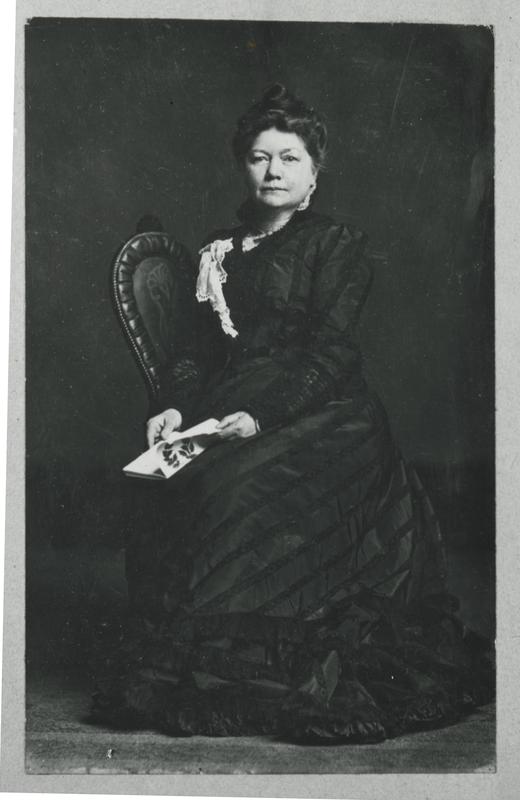When a current UNC Greensboro student walks down College Avenue, they see quite a different campus than an earlier student would have experienced. On October 5, 1892, the State Normal and Industrial School welcomed 176 students to the new girls college. There were only three building on the grounds – Main Building (now Foust), Brick Dormitory, and founder Charles Duncan McIver’s home. When the young women arrived, the buildings were new and unfinished, and the campus was not landscaped. It had just recently been a 10-acre corn field surrounded by farms and wood
That first year, all of the students roomed in the large Brick Dormitory. One girl later remembered that she and her fellow students were collected at the train station and dropped off at the dorm, sitting on either side of the main hall until they were given their room assignments. They students slept four to a room, sharing two double beds. Hailing from all corners of the state, almost 80% grew up on farms. In some cases, it was their first trip out of their own county, and they were both excited and anxious.
On the first day of class, the girls gathered in Main Building and were asked to form a line according to their height, with the shortest at the front. Then, they marched to the assembly room, which also acted as a chapel, filing uniformly into each row. This allowed the taller students in the back row of desks to have a clear view of the proceedings, as they only had shorter classmates in front of them. This routine continued every morning at 8:45 after the morning bell was rung. President Charles Duncan McIver addressed the students, leading a chapel period, during which he read from the Bible and made general announcements. Dr. McIver also conducted the morning ritual of “mail call,” announcing letters and packages received from home. The students would eventually move to classes, which related to their choice of academic track – pedagogy, home economics, or business. All of the classrooms were located in Main Building. The students also took science courses, such as physiology, which included the study of a real skeleton that the girls named “Miriam” in honor of Miriam Bitting, the first campus physician.
| Dr. McIver with his Students |
In the early days, the buildings on campus were lit first by oil lamps, then by gas lamps, and finally by electricity. Each student was responsible for her own lamp, as well as for keeping her room clean and her bed made. As there was little money from the state to hire additional kitchen workers, the girls also helped in the large dining hall that was located in Brick Dormitory, taking turns setting the tables, serving the meals, and washing the dishes.
State Normal students had very little personal freedom during the first years at the school. They had to receive special permission to leave campus and only after passing the inspection of Miss Sue May Kirkland, “lady principal.” Kirkland was “custodian of manners and morals” and “referee in matters social and domestic.” Wearing hats and gloves was mandatory and acting in a proper demeanor was expected at all times. Although Miss Kirkland was committed to decorum, she was also kind and sympathetic and the students were devoted to her.
Some of the most popular activities on campus were memberships in clubs (such as the YWCA, the bird club, the glee club, the drama club) and literary societies. Although McIver did not allow social sororities on campus, he gave the girls the opportunity to join either the Adelphian or the Cornelian literary society, which hosted debates, plays, dances, teas, and other campus entertainments. The students also valued sports, especially tennis, basketball, and field hockey, which they played in blousy black serge gymnasium outfits with black cotton stockings and leather shoes. Special events were also planned, such as the “County Fair,” which was held in 1894. The outdoor pageant featured students from each county in the state putting on a skit representing a unique characteristic of the area. The fair proved so popular, it was held several times, especially for visitors.
| Students participating in the “County Fair” |
As the student population grew during the next few years, the campus began to expand, adding Guilford/Midway Dormitory, the Students’ Building (incorporating classrooms, a large assembly hall, and space for the literary societies), and the Carnegie Library (now the Forney Building). Other buildings disappeared, such as the first barn and Brick Dormitory, which burned to the ground in 1904. As expected, new faculty came to the school, and others moved on. Other changes were unforeseen. The school’s energetic and charismatic founder and first president, Charles Duncan McIver, died in 1906, just a few weeks short of his 46th birthday.
Yet, on October 5, 1892, the campus crackled with excitement! The students were thrilled to be a part of the first class of State Normal. They knew that Dr. McIver and Miss Kirkland were at the helm and all was right with the world.
By Kathelene McCarty Smith

